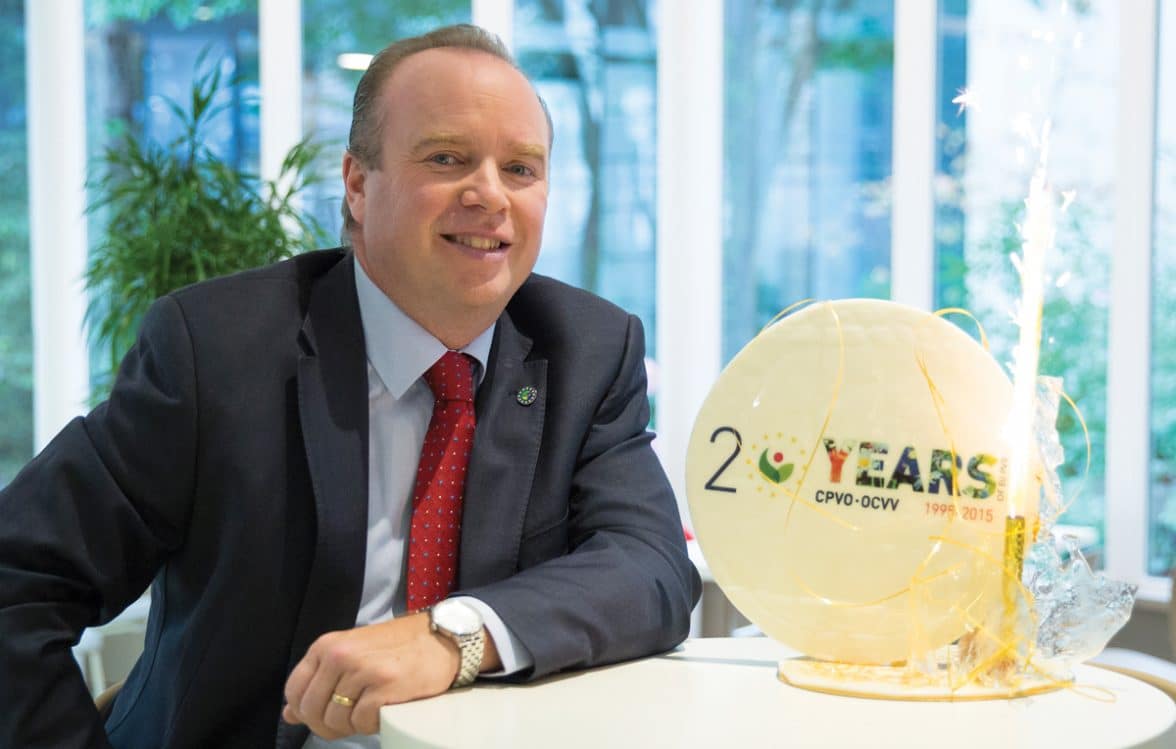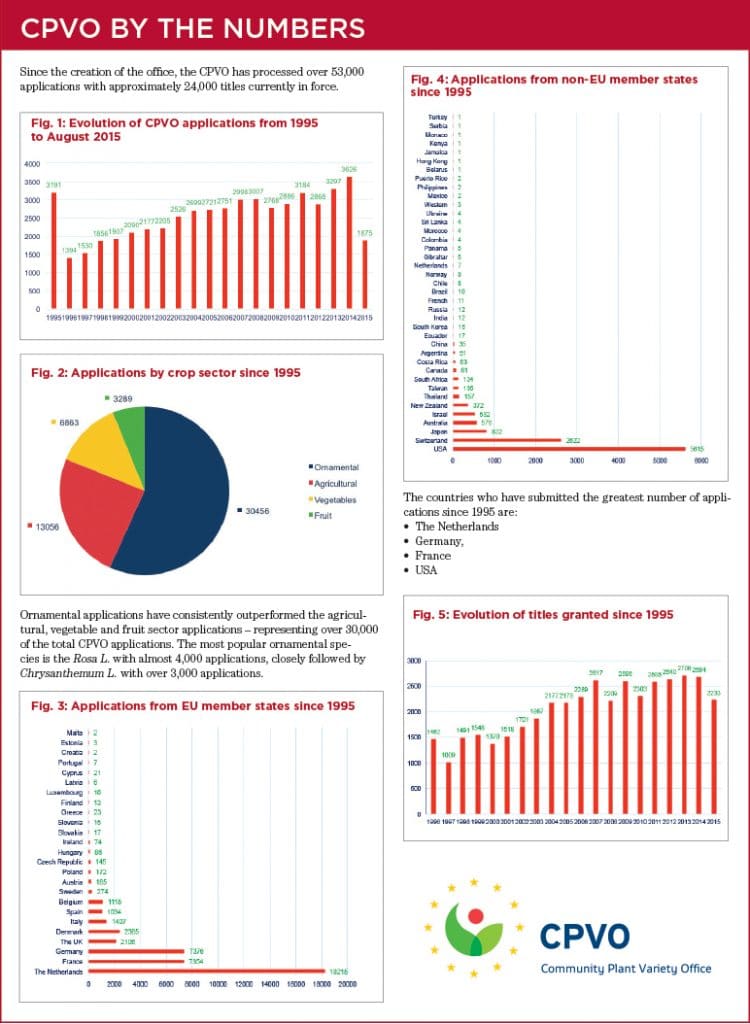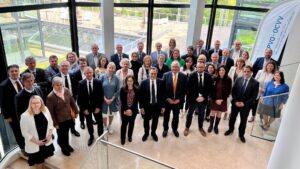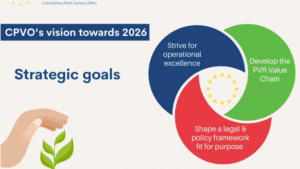Ensuring that plant breeders can do their jobs, the Community Plant Variety Office shares its reasons for 20 years of success.
European Seed: Could you please provide an overview of the Community Plant Variety Office (CPVO): when was it started, what was the reason why it was set up?
Martin Ekvad: The CPVO was established in 1995 to promote and facilitate the single market and plant breeding. The system was welcomed by the industry, amongst other reasons, because it reduces the administrative burden on breeders and streamlines market access for new varieties. With just one application to the CPVO, in any of the official EU languages, breeders can obtain an EU-wide enforceable right, which protects their creation. This also eliminates the requirement to lodge separate applications in each Member State, a procedure that was both expensive and time consuming.
One of the primary reasons for the creation of the CPVO was to encourage plant diversification and innovation. This was to be done by granting breeders the possibility to make a return on their investment through the single market.
In its headquarters in Angers, the CPVO manages the EU system of PVR applications. We do so by ensuring that applications are dealt with efficiently and that decisions delivered are well founded. When the CPVO was established, it was decided to utilise the existing national infrastructure of variety testing. Using national examination offices to execute the distinctness, uniformity and stability (DUS) testing required for the integrity of the PVR system, allowed the CPVO to benefit from and build upon the expertise already accrued at the national level while revising EU standards. Today, the CPVO is working with an effective and efficient network of Examination Offices (EO), spread across the Member States. The enhanced cooperation between EO, initiated after the creation of the EU Plant Variety Protection (PVP) system, has led to an increased harmonisation of technical and practical methods of DUS testing in the EU.
The EO must be entrusted by the Administrative Council of the CPVO (CPVO AC) based on recommendations from the CPVO’s Quality Audit Service (QAS). Entrustment of EO is an ongoing procedure; the CPVO’s QAS regularly visits, inspects and offers constructive feedback to all EOs. The QAS system ensures the continuous harmonisation, protection and promotion of the EU standard for DUS testing and plant varieties. To complete the overview of the CPVO one must stress the importance of the CPVO AC, which is the governing body composed of one member from each EU Member State and one member from the European Commission. The industry participates in these meetings as observer associations, which represent breeders. In addition, the UPOV Office is an observer to the CPVO AC. The CPVO AC also acts as the budgetary authority for the CPVO, an important task for a self-financed agency.
ES: What would you say is the main aim of the CPVO?
ME: Plant breeding requires a substantial time, up to 20 years to create a new variety, and monetary investment. Without the potential revenue stream of royalties, there would be no incentive for breeders to develop new and improved varieties. At the CPVO, we work both with and for the breeders to promote and protect plant innovation and R&D. The CPVO continuously strives to be more efficient in processing applications and assessing candidate varieties in order to reduce costs to clients and increase the quality of the service provided.
To date, advancement in crop yields have allowed farmers to consistently produce more with less. For example, UPOV estimates that improved varieties have accounted for more than 50 per cent of overall yield increases for important crops in Europe, benefitting both breeders and society.
Our mission statement best sums up the CPVO’s role:
“To foster innovation in plant varieties by high quality processing of applications for Community plant variety rights at affordable costs while providing policy guidance and assistance in the exercise of these rights for the benefit of stakeholders.”
Simply put, it is our job to ensure that plant breeders can do theirs – getting new and improved plants onto the market as soon as possible.
ES: Could you provide a brief description of the organisational structure, and explain how the seed sector is involved in the decision making process of the CPVO?
ME: As one of only two fully self-financed EU agencies, the CPVO’s budget depends on fees paid by the seed sector. Similarly, the seed sector depends on the CPVO to provide PVR services at EU level. This interdependence fosters understanding, cooperation and open dialogue between the CPVO and the seed industry. We pride ourselves on our thorough understanding of the seed sector, which ensures that our decisions on the running of the system are based on the sector’s real needs.
The CPVO works closely with the Commission (the initiator of EU legislation) and the Member States – who form part of the CPVO AC. The industry is represented in the CPVO AC by the European Seed Association (ESA), the International Community of Breeders of Asexually Reproduced Ornamental and Fruit Plants (Ciopora) and Plantum, who participate in the CPVO AC meetings as observers. This means that the industry can have its say on almost all aspects of how the office is run. It is nevertheless important to emphasize that the agency is an independent body. This is why an independent committee, composed entirely of CPVO staff members, makes decisions on individual applications.
Representatives of the seed sector also participate in the CPVO’s technical meetings, where technical protocols are developed. Technical protocols outline and describe how varieties are tested and described; they are the backbone of the PVR system. The involvement of the seed sector as regards the development of DUS testing ensures that the CPVO makes informed decisions. Observers are also regularly invited to ad hoc working groups of the CPVO.
ES: What (regulatory and other) changes have been made since its inception 20 years ago?
ME: Due to the success of the current system, it was not deemed necessary to drastically reform EU PVP. A statement supported by the 2011 independent evaluation report carried out on the functioning of the CPVO. This report informed us that the system functions well and that stakeholders are generally happy with it and wish to retain the system in its current form. That said, the report did suggest certain changes, which we welcomed. It will be up to the EU legislator to decide if and when the founding regulation governing the EU PVP system should be amended.
An important component for excellent customer service is transparency. The Office’s transparency policy was formalised in 1999. It was subsequently updated in 2003, to include specific rules on public access to documents. In 2003, the CPVO created a new financial regulation, which aligned the CPVO’s financial regulation to that of other EU institutions – making the CPVO more financially transparent.
The CPVO ensures that its work has a high level of visibility. This concern is all the more important as the CPVO seeks above all to act in the interests of the citizens of Europe, the seed sector and the breeders.
An important procedural change was the opening up of the CPVO application system in 2008. This allowed the CPVO to accept applications from any natural or legal person. Previously, applications were limited to persons from EU Member States or UPOV members.
The system for online applications was introduced in March 2010, this has proven hugely popular among clients – last year 78 per cent of all CPVO applications were submitted online. The increase in online applications has allowed the CPVO to reduce processing times for applications. The decline in paper applications has also allowed the CPVO to streamline some administrative work, instead focusing on improving our client service.
We have used technology to strengthen the EU PVR system by developing publically accessible tools such as Variety Finder and the PVR Caselaw Database. These tools allow people to easily see which varieties are protected and to find the case law, which develops the EU PVR system.
ES: Which special events have you organised to celebrate your 20th anniversary in 2015?
ME: Our efforts to mark this special occasion allow the CPVO to reflect on accomplishments, none of which would have been possible without the constant cooperation and support of the seed sector. Indeed, 2015 is the ideal opportunity for the CPVO to extend our most sincere thanks to the sector. It is also an excellent occasion to thank the staff of the CPVO for their diligence and their outstanding contributions to the CPVO.
The CPVO will mark the occasion by hosting a seminar with participants from across the field of seeds and plant variety protection, including Commissioner Andriukaitis, Secretary General of UPOV, Francis Gurry and Chair of the European Parliament’s Agriculture Committee, MEP Siekierski. This seminar will provide a valuable opportunity to reflect on past achievements and the future of the sector and the agency.
ES: The CPVO is one of the most successful organisations within the EU, and had to decrease the fees from time to time. How do you explain the great success of the CPVO? What aspects should other EU organisations copy to be as successful?
ME: The success of the CPVO is due to a mixture of devoted staff and open dialogue with the seed sector and other stakeholders. I think that keeping focused on the core activities of the CPVO was a major contributor to our success. Having said that, I see various areas where the CPVO could, in the future, expand its remit to do important work in related fields without jeopardising the efficiency of the PVR system.
We are ever conscious of the need to provide an excellent service at the lowest possible cost. Reduction of CPVO fees is a choice we proactively work towards. This policy has resulted in consistent fee reductions. The CPVO AC has also sought approval, from the European Commission, to reduce the online application fee next year, a reduction which we expect to benefit more than 75 per cent of our clients and will encourage others to use our online service.
However, there is one area in which fees have not been reduced – technical examination fees. I think that fees for technical examinations are fair but I am conscious of the need to keep them at a reasonable level. However, costs vary depending on the species in question and it is important to reflect on how best to keep costs at reasonable levels for all species without jeopardising our standards. The use of bio molecular technology as support tools in such examinations should be explored. The CPVO looks forward to working with stakeholders to find a solution that will benefit everyone and an open dialogue with the industry will be crucial in this respect.
ES: Have other organisations tried to copy the CPVO model? Is CPVO providing support to such organisations?
ME: The CPVO works with both the l’Organisation Africaine de la Propriété Intellectuelle (OAPI) and the Africa Regional Intellectual Property Organisation (ARIPO). We are engaged in and enthusiastic about the work done by these organisations for the development and implementation of the plant variety rights system in their regions. The introduction of PVP in new regions is positive for the farmers of those regions who will profit from new, better performing varieties. This is good news for local breeders as well as EU breeders who seek to trade on the global market.
In particular, we congratulate the recent accession of OAPI to UPOV, a very important step for the West African region. We are currently working with OAPI and other partners, to assist OAPI to develop its regional system through training and exchange of expertise.
We also congratulate ARIPO for the adoption of a Protocol for Protection of New Plant Varieties in ARIPO member states in July 2015. The CPVO actively participated in many ARIPO expert meetings, which led to the adoption of this protocol, in the years preceding.
I witnessed the importance African politicians attach to improving agriculture and agricultural yields including the need to develop better performing varieties.
The CPVO and the EO participate in workshops, expert meetings and training sessions to assist the development of the ARIPO and OAPI regional systems. I relish the opportunity to share, support and offer guidance to other regional PVP organisations that wish to follow in our steps.
ES: One can imagine that it would be good that other regions, e.g. in Asia or South America would adopt a similar successful approach just like the CPVO. Are there any plans or attempts in this direction? What would need to change to make this happen?
ME: Many varieties protected under the EU system, especially ornamentals, have a strong demand outside the EU. It is in the interest of breeders that varieties protected under the umbrella of the EU system also have easy access to outside markets, where their variety will be equally protected. Ultimately, the development of PVP systems in other regions depends on the political will of governments, stakeholders and civil society of those regions.
The CPVO regularly participates in training courses organised by UPOV for South American countries as well as meetings and seminars organised by the East Asia PVP forum and the Asia and Pacific Seed Association (APSA). The CPVO also welcomes visits from delegations from Asian countries, interested in learning more about the EU regional system for PVP and has offered training for experts from South American countries. Where appropriate the CPVO highlights the advantages of the EU regional system, enhanced cooperation amongst entrusted EO from different member states and the relevance of shared databases, on which the CPVO has extensive experience.
ES: Besides Plant breeder’s rights applications, the CPVO also engages in research projects. Why is this important and how is this to the benefit of the plant breeders?
ME: Representing the largest PVP system in the world, it is vital that the CPVO act as a leader by developing new and better tools to reduce the labour and costs associated with DUS tests. At the CPVO, we balance a system based on the assessment of morphological characteristics with the ability to innovate and to adapt to technological advances.
The projects we fund focus on the following areas: DUS testing, identification of varieties or organisation and management of reference collections. The CPVO selects projects, which will have a concrete impact on the quality of DUS testing. In 2014, the CPVO AC revised the CPVO’s R&D strategy. The following were considered as R&D priorities:
• The setup of shared online databases of reference collections available to CPVO entrusted EO.
• Use of bio molecular techniques for the management of reference collections, identification of reference materials, enforcement and support of DUS assessment.
• Improvement and harmonization of methodologies and procedures included in the CPVO technical protocols.
The CPVO would like to promote the use of molecular markers in DUS testing, within the network of EO as well as shared databases of variety descriptions and administrative data. We hope that, by supporting research on the use of new tools for testing, we can ensure future cost reductions and improved DUS testing. We must seek, support and embrace new developments in the field of PVP testing. Investment in viable R&D projects is imperative for the future of the EU PVR system.













